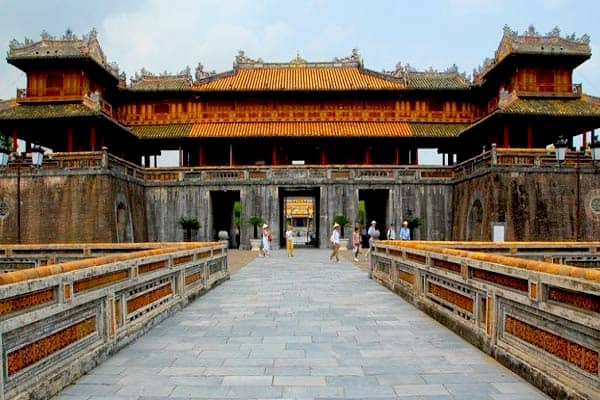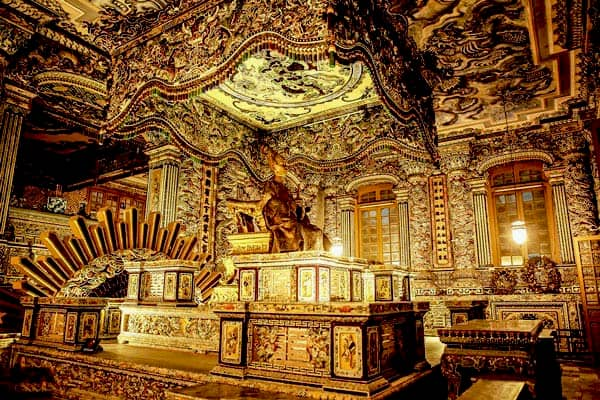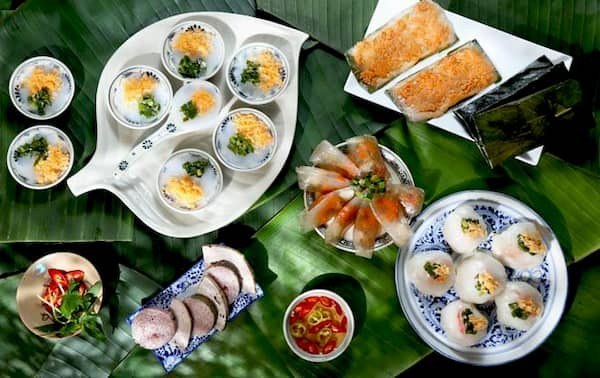HUE - CENTRAL VIETNAM
A DESTINATION FOR CULTURE LOVERS
Former imperial capital of Vietnam from 1802 to 1945, Hue is a city belonging to the province of Thua Thiên-Hue of which it is the capital. Hué is located south of the 17th parallel, in central Vietnam. The Sông Huong River (Perfume River in French) flows through the city, separating the old town to the north and the modern city to the south.
History of Hue
Hue is a city renowned for its very cultural side, especially because it was the imperial capital of the country since 1802. Thus, the city had become the imperial residence and one can still feel the influences of refinement and prestige on gastronomy, art and architecture today.
However, over the course of history, a large part of the city has been destroyed and many buildings that existed in the past can no longer be visited today despite renovation work.
In 1945, the city lost its status as an imperial city following the abdication of Emperor Bao Dai.
Then, in 1968, the city was attacked by the North Vietnamese and suffered many casualties despite an assault that was finally repelled. Thereafter, it was the Americans who bombed the Imperial City. The city was taken over by the Vietnamese People's Army in 1975.

The entrance to the Imperial Citadel in Hue
What to do in Hue?
Hué has several assets to attract tourists from all over the world. It should also be noted that a group of monuments in the city was classified as a UNESCO World Heritage Site in 1993.
Imperial city
The first monument of this complex is the Royal Citadel, which is the most popular symbol and visit of this central Vietnamese city. It is an enclosure forming a perimeter of more than 10 km, surrounded by a moat and accessible by 10 fortified gates with a bridge each. The 4 main gates are the Gate of Peace (north), the Gate of Humanity (east), the Gate of Virtue (west) and the Gate of the South (south). The Royal Citadel housed the administrative buildings.
Inside the Citadel is the Imperial City, which enters through the Gate of Middle Day. This city was intended to house the royal palaces as well as the places of pilgrimage.
Finally, through this city and the Pond of the Golden Waters (a pond filled with water hyacinths and goldfish), it is possible to access the Forbidden Purple City. The latter was used to house the royal residences. Today, there is only a courtyard and the remains of the surrounding walls. However, the East and West pavilions have been restored by UNESCO.
The An Dinh Palace also deserves attention. This palace was built at Khai Dinh's request when he became king in 1917, on land that his father had given him in 1902 and far from the Imperial City Court because he had many enemies.
The construction of the palace was completed in 1919, in a European style. Inside the palace there are many frescos and panels painted and framed, with motifs representing the landscapes around Hue.
The tombs of kings
The mausoleums and tombs of the Nguyen kings are then found in this complex. These tombs are located on the banks of the Perfume River. The four most famous and visited tombs are as follows:
The tomb of Gia Long (or Thien Tho tomb): It is a complex extending over 42 hills, containing several tombs and burials of members of the royal family.
Minh Mang's tomb (or Hieu's tomb): This mausoleum is composed of 40 monuments (temples, pavilions, palaces,...). The large Dai Hong Mon Gate is the main gate. However, it was only opened once, in order to allow the royal coffin to pass through. Visitors must therefore pass through both side doors.
The tomb of Tu Duc (or Khiem tomb): Unlike the other kings, Tu Duc was finally not buried in his tomb but in another place still kept secret today. However, it is still possible to visit the tomb, which was used at the time as a country residence for Tu Duc.

Inside the tomb of Khai Dinh
Khai Dinh's tomb (or Ung tomb): This mausoleum is built on the slope of Chau Chu Mountain. It is a tomb that differs from the others in many ways. First of all, it is much smaller. Then it was built in a style that mixed Asian and European architecture, as Khai Dinh had been impressed by Western architecture on his various trips. Khai Dinh's tomb is also the last such tomb to have been built for a member of the Nguyen dynasty.
All these tombs were built during the reign of each king, while respecting the personality of each one.
Finally, all UNESCO listed monuments are complemented by some temples, pagodas and other structures.
The pagodas
Concerning the pagodas, we can mention the Thien Mu pagoda (Celestial Lady pagoda), whose name comes from a local legend. The Phuoc Duyen tower is the main element of the pagoda, with 7 floors and a height of 21 m. The Tu Hieu Pagoda, built in 1848 north of Tu Duc's tomb by the high-ranking eunuchs of the Imperial City, is also interesting. A pond containing lotuses with a crescent-shaped shape is nearby.
The cuisine of Hue
Gastronomy is also a strong point in Hue. It is characterized by a refined side with complex flavors. We are also talking about the culinary art of the Royal Court of Hue, which would represent the pinnacle of Vietnamese gastronomy and is considered as a national cultural heritage.
This art really developed under the reign of King Gia Long (1762-1820), the first king of the Nguyen dynasty. The dishes were refined, whether in terms of choice of ingredients, preparation or presentation.
Apart from the royal cuisine, Hue's cuisine also includes popular and vegetarian cuisine.
Hue's popular cuisine uses many spices, with colourful dishes and poetic names. Vermicelli soups, stuffed, ravioli or even pancakes are examples of famous dishes in this cuisine.
Hue's vegetarian cuisine is based on the Buddhist way of life and the city's past. Indeed, the monks and monks follow a strict vegetarian diet while the practitioners do not eat meat or fish during the 1st and 15th day of the lunar months. The Hué countryside offers generous vegetable gardens to provide vegetarians with dishes of the same level as royal or popular cuisine.

The specialties of Hue
The city of Hue is thus exceptional and visiting it is extremely enriching. Its many monuments combined with its typical cuisine make it one of the main destinations for visitors to Vietnam. If you are interested in the country's culture and culture in general, Hue is an essential destination for you during your trip to Vietnam.
Some tips during your stay in Hue
- Hué has many things to visit, but if you have time, enjoy a bike ride in the countryside in complete serenity.
- In addition to enjoying the incredible cuisine in the city, you can also cook a typical dish yourself during a cooking class!
- The Hue Monument Complex is not the only thing listed as a UNESCO World Heritage Site. This is also the case with Nhã nhac, the music of the Vietnamese royal court. You can watch a show taking place on a boat sailing on the Perfume River and featuring a demonstration of songs and royal music.



